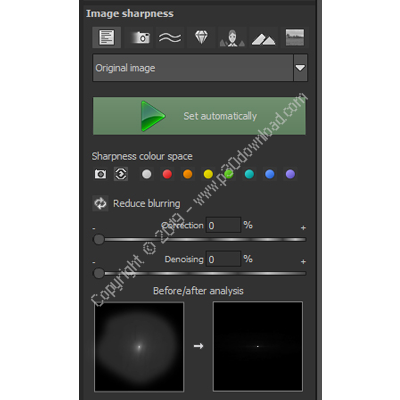

- #Sharpen projects 3 professional how to#
- #Sharpen projects 3 professional skin#
- #Sharpen projects 3 professional download#
To complete the process it is important to print the image and then decide whether the image could stand additional sharpening or whether the amount used was excessive.

Remember at this point the settings you have selected are being viewed on a monitor as a preview of the actual print. The opacity slider could be used to fine-tune the preferred sharpening routine.

Fourth test has sharpening via a localized Unsharp Mask (100%) in Luminosity mode. Third test has had the blend mode of the High Pass layer changed to Overlay mode. Second test uses a High Pass layer (3 pixel radius) in Soft Light mode. The RAW image was processed with 15% sharpening. Type 0 in the Hue and Saturation fields and 50% in the Brightness field of the Color Picker.ĭetail from a portrait captured on a Nikon D1x. This technique is especially useful for limiting the visual appearance of noise or film grain.Ĭlick the Foreground color swatch in the Tools palette to open the Color Picker. Paint the High Pass layer to remove any sharpening that is not required, e.g. Enter 0 in the Hue and Saturation fields and 50% in the Brightness field to choose a midtone grey. Note: To adjust the level of sharpening later you can either adjust the opacity of the High Pass layer or set the blend mode of the 'High Pass' layer to 'Soft Light' or 'Hard Light' to increase or decrease the level of sharpening.Ĭlick on the Foreground color swatch in the Tools palette to open the Color Picker. Increase the pixel radius in the High Pass dialog box until you achieve the correct amount of sharpening. A pixel radius of 1.0 if printing to Gloss paper and 3.0 if printing to Matte paper would be about normal.Ĭhoose Overlay from the blend modes menu in the Layers palette and then choose Filter > Other > High Pass.

Increase the pixel radius until you achieve the correct amount of sharpening. Select 'Overlay' from the blend modes menu in the layers palette.Ĭhoose Filter > Other > High Pass. Reduce the levels of sharpening later if it proves too much.ĭuplicate the background layer and set the blend mode to Overlay. adjust the color and tonality of the image before starting this advanced sharpening technique. The sharpening process that follows should also come at the end of the editing process, i.e. It is also not advisable to sharpen images that have been saved as JPEG files using high compression/low quality settings. The sharpening features found in most capture devices are often very crude when compared to the following technique. Note: If you have any sharpening options in your capture device it is important to switch them off or set them to minimum or low (if using camera RAW set the sharpening amount to 0). These advanced techniques are essential when sharpening images that have been scanned from film or have excessive noise, neither of which needs accentuating by the Unsharp Mask.
#Sharpen projects 3 professional skin#
sharpening the eyes of a portrait but avoiding the skin texture. The best sharpening techniques are those that prioritize the important areas for sharpening and leave the smoother areas of the image well alone, e.g. Too much and people in your images start to look radioactive (they glow), not enough and the viewers of your images start reaching for the reading glasses they don't own. Think of it as a localized contrast control. These filters are programmed to make the pixels on the lighter side of any edge it finds lighter still, and the pixels on the darker side of the edge darker. The basic concept of sharpening is to send the Unsharp Mask filter or Smart Sharpen filter on a “seek and manipulate” mission. The best sharpening techniques prioritize certain areas in this case, sharpening the eyes of a portrait but avoiding the skin texture. The actual amount of sharpening required for optimum image quality is usually a little more than looks comfortable on screenespecially when using a TFT monitor (flat panel). If sharpening for screen it is very much a case of “what you see is what you get.” For images destined for print however, the monitor preview is just that - a preview. Sharpening in Adobe Photoshop CS2 will allow you to select the precise amount of sharpening and the areas of the image that require sharpening most. Most cameras or scanners can sharpen as the image is captured but the highest quality sharpening is to be found in the image editing software. Most if not all digital images require sharpening, even if shot on a state of the art digital megaresolution SLR with pin-sharp focusing.
#Sharpen projects 3 professional how to#
How To Sharpen An Image In Photoshop Advanced Photoshop Sharpening TechniquesĪdapted from " Photoshop CS2: Essential Skills" by Mark Galer and Philip Andrews
#Sharpen projects 3 professional download#
Download any Adobe product for a free 30 day trial.


 0 kommentar(er)
0 kommentar(er)
